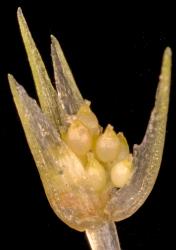- = Juncella F.Muell. ex Hieron. in Engler & Prantl, Nat. Pflanzenfam.II, 4, 15 (1888)
- = Hydatella Diels in Diels & Pritzel, Bot. Jahrb. Syst. 35: 93, fig.7 (1904)
Perennial (NZ & Tasmania) or annual herbs; tufted from an erect, shortly branching rhizome. Coteylodons free or united. Leaves spiral, 1-veined; lamina linear-filiform, air canals well developed. Reproductive unit an involucre of hyaline bracts 2–30 (NZ mostly 2 or 4). Stamens 1–17 per reproductive unit; anthers 0.3–2.8 mm long basifixed on filaments 1–5 mm long; pollen oblong or rounded, monosulcate, tectum perforate, exine surface microechinate. Carpels (2–)10–40 per reproductive unit, stipitate, on persistent stalks; uniseriate stigmatic hairs 0.2–5.0 mm long. Fruits dehiscent (2 or 3-valved) or indehiscent. Seeds sculptured or not.
Most species are semi-aquatic annuals (of Australia) associated with seasonal ephemeral pools and wetlands, two species are fully aquatic perennials of permanent lakes, one in New Zealand and the other in Tasmania. Recent molecular phylogenetic analyses of Trithuria have resolved four lineages that Iles et al. (2012) have formerly classified into taxonomic sections, diagnosable by fruit and seed characters. Trithuria inconspicua is a sister species to T. filamentosa of Tasmania and both are classified in section Hydatella (Iles et al. 2012, 2014) along with T. austinensis and T. australis of Western Australia. This section is diagnosed on the basis of: an absence of pericarp ribs and papillae, a thick seed cuticle, and possibly the presence of leaf-sheath auricles (Iles et al. 2012).
Trithuria is adapted to wind pollination (Taylor et al. 2010) and not submerged hydrophily, despite flowers opening underwater (Edgar 1966). In T. submersa Taylor et al. (2010) showed that emergence was necessary for both pollen release and reception. Species of Trithuria have evolved both strong selfing and outcrossing breeding systems (Taylor & Williams 2012) and exhibit dioecy, autogamy and apomixis. Evidence for apomixis in T. inconspicua and T. filamentosa is based on near permanent submergence of flowering plants below the water surface (Edgar 1966) and rarely emergent except during prolonged drought conditions; by pollen abnormalities (Hamann 1976, Remizowa et al. 2008); and by embryo development with an absence of pollen tubes (Rudall et al. 2008). Genetic population studies (Smissen et al. 2019) have provided further evidence that T. inconspicua and its sister species T. filamentosa are apomictic, although possibly with a recent history of at least occasional sexual reproduction.
The minute tufts with monocot-like linear leaves are very different to the macrophytes of Cabombaceae and Nymphaeaceae. Trithuria also differs significantly in flower morphology, with non-showy bracted ‘reproductive units’ (flowers or inflorescences) and with stalked, free carpels with multiseptate stigmatic hairs directly attached to the carpel apex. Most species are semi-aquatic (ex T. filamentosa and T. inconspicua) and inhabit ephemeral water-bodies that are flowering and fruiting above the receding waterline.
Trithuria Hook.f. has 13 species; 11 endemic to Australia, and 1 endemic to each of New Zealand and India (Sokoloff et al. 2008).
| Category | Number |
|---|---|
| Indigenous (Endemic) | 1 |
| Total | 1 |
T. inconspicua subsp. inconspicua 2n = c. 24 (de Lange et al. 2004); T. submersa 2n = 56 (Kynast et al. 2014).




